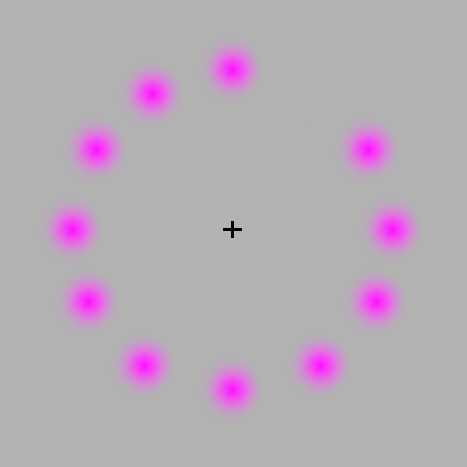The year of the eye has come to an end.
Looking back of the year with all its optic topics turned out to be more like the year of light, how it is perceived, how it behaves and how it effects and determines our perceptions of the physical properties of objects. Quite scientific and less spontaneous than the year of colour, perhaps because colour is easier to read than light.
My questions of what colour is the wind and how we see glass where all answered by the trasmission of light wavelengths either being absorbed, reflected and/or scattered at varying angles.
However there is still magenta...... which was never really answered in any of the topics.
So what colour is magenta and is it really a colour?
Look at the pink circle for on minute below and then look over to a blank white space next to the image. What do you see? What colour is the after image?
You should see a green after image. Why?
The afterimage always
shows the colour that is complementary to the colour
of the image. Complementary colours are those that
are exact opposites in the way the eye perceives
them.
The light spectrum consists
of a range of wavelengths of electromagnetic radiation.
Red light has the longest wavelength; violet the
shortest. The colours in between have wavelengths
between those of red and violet light.
When our eyes see colours, they are actually detecting the different wavelengths of the light hitting the retina. Colours are distinguished by their wavelengths, and the brain processes this information and produces a visual display that we experience as colour.
This means that colours only really exist within the brain – light is indeed travelling from objects to our eyes, and each object may well be transmitting/reflecting a different set of wavelengths of light; but what essentially defines a ‘colour’ as opposed to a ‘wavelength’ is created within the brain.
If the eye receives light of more than one wavelength, the colour generated in the brain is formed from the sum of the input responses on the retina. For example, if red light and green light enter the eye at the same time, the resulting colour produced in the brain is yellow, the colour halfway between red and green in the spectrum.
So what does the brain do when our eyes detect wavelengths from both ends of the light spectrum at once (i.e. red and violet light)? Generally speaking, it has two options for interpreting the input data:
a) Sum the input responses to produce a colour halfway between red and violet in the spectrum (which would in this case produce green – not a very representative colour of a red and violet mix)
b) Invent a new colour halfway between red and violet
Magenta is the evidence that the brain takes option b – it has apparently constructed a colour to bridge the gap between red and violet, because such a colour does not exist in the light spectrum. Magenta has no wavelength attributed to it, unlike all the other spectrum colours.
The light spectrum has a colour missing because it does not feel the need to ‘close the loop’ in the way that our brains do.
When our eyes see colours, they are actually detecting the different wavelengths of the light hitting the retina. Colours are distinguished by their wavelengths, and the brain processes this information and produces a visual display that we experience as colour.
This means that colours only really exist within the brain – light is indeed travelling from objects to our eyes, and each object may well be transmitting/reflecting a different set of wavelengths of light; but what essentially defines a ‘colour’ as opposed to a ‘wavelength’ is created within the brain.
If the eye receives light of more than one wavelength, the colour generated in the brain is formed from the sum of the input responses on the retina. For example, if red light and green light enter the eye at the same time, the resulting colour produced in the brain is yellow, the colour halfway between red and green in the spectrum.
So what does the brain do when our eyes detect wavelengths from both ends of the light spectrum at once (i.e. red and violet light)? Generally speaking, it has two options for interpreting the input data:
a) Sum the input responses to produce a colour halfway between red and violet in the spectrum (which would in this case produce green – not a very representative colour of a red and violet mix)
b) Invent a new colour halfway between red and violet
Magenta is the evidence that the brain takes option b – it has apparently constructed a colour to bridge the gap between red and violet, because such a colour does not exist in the light spectrum. Magenta has no wavelength attributed to it, unlike all the other spectrum colours.
The light spectrum has a colour missing because it does not feel the need to ‘close the loop’ in the way that our brains do.
We need colour to make sense of the world, but equally
we need to make sense of colour; even if that means
taking opposite ends of the spectrum and bringing
them together.
It would appear that our brains process and perceive colours when colours are together. Basically a colour isnt a colour when its standing alone, perhaps not in reality but definitely in our minds.
And here is where 2013 year of combinations will start......




























